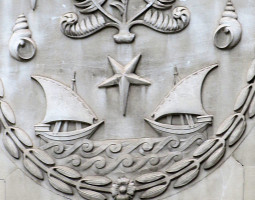
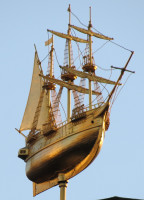
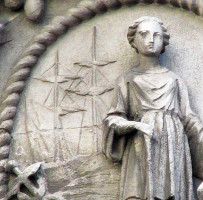
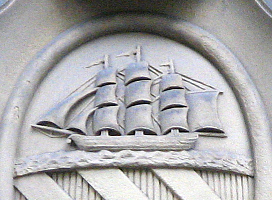
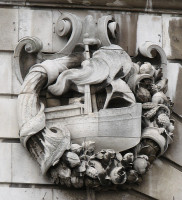
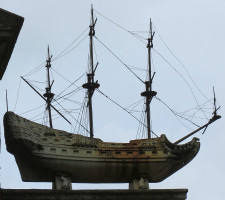
Ships in sculpture are fairly frequent in Britain, as might be expected for a maritime nation. Shown above are some typical examples, including a pair of simplified sailing boats subsumed to a decorative scheme, a ship weathervane, a figure emblematic of English Trade with the lightest of low relief ships sketched in the background, along with other symbols of trade, a many-sailed fast trading ship, a cartouche made up of a steamship with the the smoke from the funnel and an overflowing cornucopia forming the surround, and a free-standing ship in stone with metal rigging on a nautical almshouse. Below left is an example with sailors hauling a boat on to a beach. It is a rather large sculpture (the figures are full size) which few look at, high up above Regent Street on the façade of the Liberty’s Building (No. 208-222 Regent Street). On the same building are little ornamental ships as clasps for obelisks: in both cases the ship is a symbol of trade from distant lands, most relevant to a shop with imported and exotic wares for sale.
Stone and bronze ship sculpture on the Liberty's Building, Regent Street.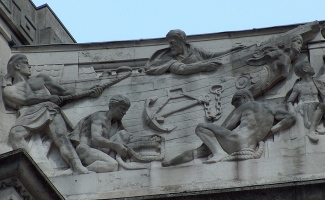
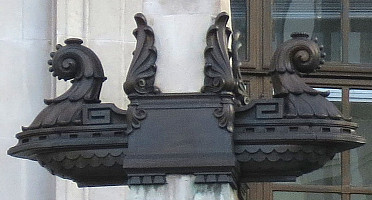
Ships are most common as high relief sculpture. The example below centre has a many-oared ship with a sail as well, and what appears to be a small tower; it forms the design on a shield held by a merman and mermaid as supporters. Next, some great galleon, seen with all its many gun-hatches, closed here, as the ship sails away from us on a calm sea. The two flanking pictures are examples of more modern ships, both shown coming towards us, suggestive of speed.
More examples. Below left is one not on the face of a shield or boss, but at its top, a tubby little sailing ship, with stylised waves, and at the base, the face of some river god (you’ll need to click on the small image to see this). The other sculptural detail is floral: little flowers of the bluebell type, and olive branches. Next, a fishing scene with a small fishing vessel being unloaded, this being one of a series of relief sculptures by the sculptor Henry Bonehill in Manchester. Then a single sailed vessel, with a carved figurehead, as part of a decorative scheme on the corner of a building. And to the right, a Cutty Sark type of clipper, with many sails, forming part of a design with rather Tudor designs symbolising England, Scotland, Ireland and Wales, and with two leaping fish.
Next, below, we have another ship with many sails in a decorative scheme, without the sea beneath, but rather ribbons suggestive of waves. Then a great sea battle, from the front of Deptford Town Hall, by the sculptor Henry Poole – a most spirited piece, with all sorts of details which can be seen if you click on the picture to enlarge it, but could not really be appreciated on the actual building from the ground down below without some visual aid. Then another decorative piece, with wht appears to be a dockside scene.
A three dimensional alternative for architectural sculpture is the prow of a ship. Below left, a ship's prow as an emphasis on the corner of a late Victorian Queen Anne style building, with finny embellishments underneath, and cornucopias on the side, these being again evocative of trade and prosperity and thus appropriate for a commercial building. Then an example from the ballustrade of a building, with a king’s head thrusting forward, more of a battering ram than a figurehead; note the two little dolphins in the water at the base. Then a combination of ship’s prow – here bearing a lion head, and the relief of a ship, most delicate (you will need to click to enlarge to see this), all in cast iron. Then an example of the prow of a ship in full sail, with great fishes writhing on each side. The next example is a carved keystone above an arch, with a ship's prow and forward-facing square sail, an effective composition economically filling the available space. Finally, to the far right, in iron again, is the front of a ship above a portico with a clock, showing delicate rigging and detail.
Architectural sculpture: ship's prows.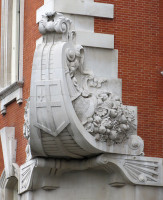
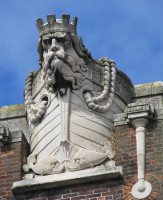
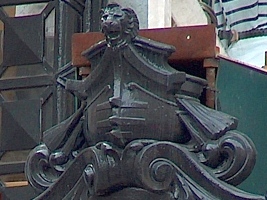
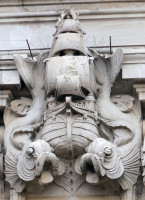
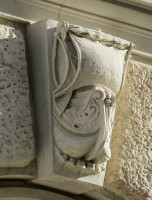
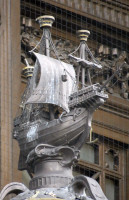
We can also find architectural figure sculpture with prows of ships, as in the example below left, which is the Progress of Communication: Shipping along Old Bailey, London. The next picture below shows one of the relief panels on the Lyceum Post Office in Bold Street, Liverpool, where a Classical girl is seated on the side of the craft, with a large parcel bound up for transport, and holds in her hand the Caduceus of Mercury, here symbolising rapid travel (see this page for more on the Caduceus in 19th Century sculpture).The next one, a modelled terra cotta panel, shows various nationalities – Chinese with long moustache and shaven head, an African man who seems to be a dockworker rather than trader, and an Arab personage in full desert costume, though oddly with bare feet – in front of the prow of a boat being unloaded by British navvies while the central figure marks off the goods in his notebook; a further ship in sail can be seen, in low relief, in the background. Finally, a heroic Art Deco figure with a Neptune trident on the balustrade of a tall building.
Figure sculpture and ship prows.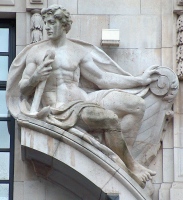
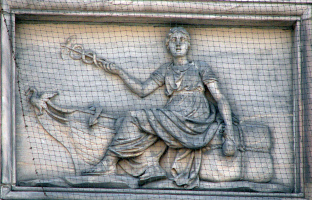
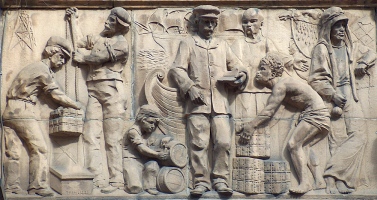
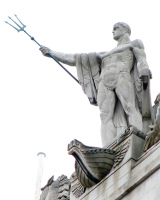
Sometimes we find allegorical figures holding ships, being symbolical again of travel and the sea. The Lloyds Registry building in Fenchurch Street, London, has some beautiful examples: a bronze standing girl bearing a modern oceian liner, and a group of girls in stone, carrying sailing vessels, are shown below - George Frampton was the sculptor. Then a panel from the interior of that building, by Lynn Jenkins, simply entitled Shipping. Next is a mer-boy holding a sail as symbol of shipping. And to the far right is a boy playing with a model of an ocean liner as the corner of a pediment.
Allegorical figure sculpture with ships.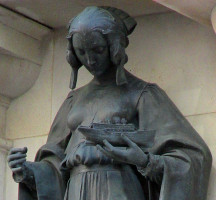
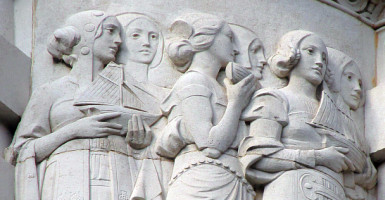
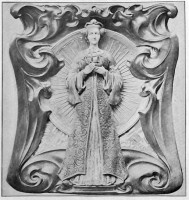
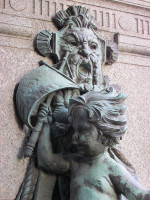
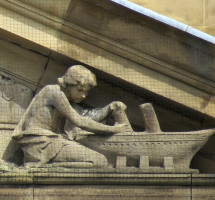
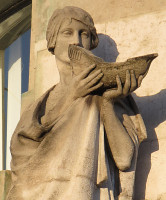
More examples of figures holding ships in architectural sculpture. Below left is a female figure carrying the hull of a ship, from another commercial building where the emphasis is on trade and commerce. Then an Oriental trader carrying his craft, with a single sail like a Chinese junk – again as symbol of trade from exotic places. Then a relief panel with two spandrel girls, one of whom carries a small ship, the other a sheaf of corn. And to the right an art deco Viking girl in low relief holding a ship.
We can also have anchors as symbols of shipping, as shown in the examples below; that to the left shows how an anchor with rigging and robe can form a convenient pyramidal heap for an architectural setting. The picture below right, a relief sculpture, has the anchor, chain and rope in front of a tower-like structure which could be a capstan to wind the rope on, or indicate the back of a galleon.
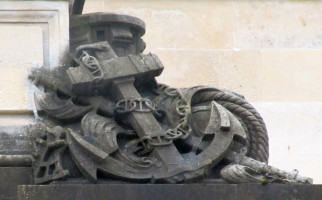
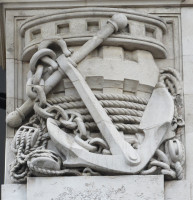 The anchor in architectural sculpture.
The anchor in architectural sculpture.
Everything so far has been ship sculpture in an architectural context. We ought also to note that ships can feature on monuments too, where the deceased was a ship’s officer or captain or admiral. Below centre are a very worn low relief of a ship from a tombstone, and a free-standing boat by the foot of a crucifix. Inside a church, there is no concern over weathering, and the two flanking examples below are mid-18th Century examples from churches on the Metropolitan Line to Uxbridge. That to the left combines the ship with a globe and sextant and other tools of the navigator; that to the right has billowing clouds on each side indicating the trade winds.
Ships in monumental sculpture.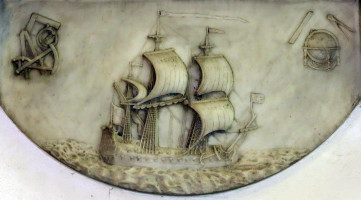
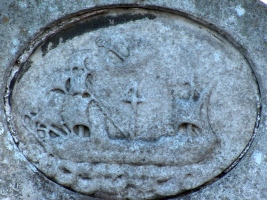
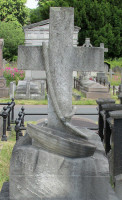
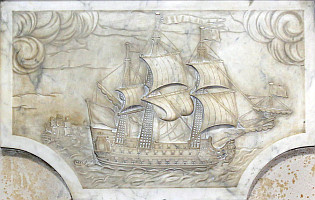
We saw anchors in architectural settings above; anchors are particularly popular on monuments, when a full ship sculpted in relief was either seen as too prone to be weathered away, or more likely, to carve such a thing was beyond the means of those paying for the tombstone, or the skill of the stonemason. Here we see an anchor with snapped rope, symbolic of the life of the nautical man being cut off unexpectedly; a crowned anchor; and in the centre, a faded relief of a seated girl mourning over an anchor as a memento mori of her deceased husband, much as more conventionally we would have a girl with a funereal urn or pot. The line of the neck and back of the semi-nude girl, the lower hem of the drape from her ankle, and the tine of the anchor, make a sweeping curve giving considerable harmony to the composition.
The anchor in monumental sculpture.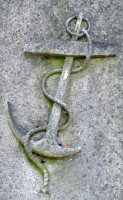
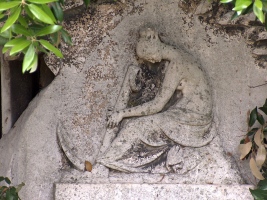
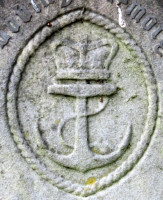
Finally, the most noticeable examples of ship sculpture, if so we can call them, are the model ships used for weathervanes. Examples are below. Three-masted vessels are the most popular, and a range of riggings and sails are shown here. Nautical buildings, those connected with trae, seaside town buildings and even churches may be decorated with such ship weathervanes.
Visits to this page from 11 April 2014: 14,556
Architecture pages // Fish sculpture // Mermaid sculpture // Merman sculpture // Allegorical sculpture